Exporting to Chat and Electronic Mail Format (EML)
The EML export option fits alongside existing RSMF 1.0, RSMF 2.0, and HTML export options. Using this export option, you can create exports of chat and short message data using ReadySuite's chat connectors (Microsoft Teams, Slack, Google Chat) and load file sources (such as Concordance DAT) in an EML file format.
Four templates exist in the installation directory for modifying the EML text and/or HTML body content. Sets of templates exist for both single message export and batched/multi-message export.
To export an EML data set from ReadySuite
- Start a Chat Project and import to ReadySuite the chat data set you want to export.
- In the ReadySuite ribbon, click External Data and click Chat to open the Chat Export wizard.
- On the Export Setup page, specify the file export destination, format, and additional settings.
- Format: Seletct from the following:
EML (per message): Exports each individual message/event as a single EML file.EML (batched): Creates a transcript of multiple messages into a single EML file using the split/slice options already available for EML load files.- After selecting an EML format, click the Gear icon and select the EML format from the following:
EML: Select for an output file with an .EML extention (recommended).NEML: Select for an output file with a .NEML extention. (Select this if generating an export for the Nebula eDiscovery platform.)- Export Path: Location of exported files. If you choose an export path that contains a previous export, ReadySuite adds a counting value to the subsequent exports. Using an empty export path folder is recommended.
- Time Zone: The time zone of the source data set (such as the Timestamp).
- Attachments: Select to embed attachments into the EML. For HTML, only certain media (.mp3, .wav. and .ogg) and images (.png, .jpg. jpeg, and .gif) can be attached. These settings can be configured in the configuration and template files.
- File Prefix: Enter a prefix for the output file if selecting an existing field (for example, Conversation Type) for use as the naming prefix for the batch. Any file created by ReadySuite will have this prefix at the start of the filename.
- File Name: If you selected the EML (per message) format, select a field to be used as the file name (for example, EventId) for each message in the batch.
- Batch By: If you selected the EML (batched) format, select the field to create base groups of conversations the EML file.
- Split By: If you selected the EML (batched) format, select to split from the following (you can select more than one):
- Platform: Source of the imported chat data (examples: Message, SMS, Microsoft Teams, Slack, Google).
- Converstation Type:
DirectorChannel. - Time:
Year,Month,Week,Day, orHour.
If you select with quiet period, select the length of the quiet period to set a threshold between periods of no messages being set when splitting an EML file. If a conversation is still occurring beyond the selected time split, but doesn't exceed the quiet period, it is still included in the original split.
- Chunk By: If you selected the EML (batched) format, select to control the total number of events included and maximum file size for any exported EML file.
- Saved Path: Select or create field that will be updated to include the full path to the exported load file.
- Click Next.
- On the Export Setup page, specify the export destination, format, and additional settings.
- Application : Select to populate the
X-CHAT-Applicationfield. (This is used to identify the source of the data, which is intended to be ambiguous. For example, it could be the application of the data contained in the EML file.) - Custodian: Select to populate the
X-CHAT-Custodianfield. (This field is used to identify from whom the data was collected from.) - Collection ID: Select to populate the
X-CHAT-EventCollectionIDfield. (This field should be a unique ID that is to be used to help keep many EML from a single conversation together. The intent with this field is to allow for better sorting of EMLs in a document list to group parent EMLs to the same conversation, if conversations or EMLs are broken up for review purposes.) - Conversation: Select any optional name/value objects to store additional metadata about the conversation.
- Participants: Select any optional name/value objects to store additional metadata about the participant.
- Events: Select any optional name/value objects to store additional metadata about the event.
- Click Next.
- On the Chat Fields page, select the fields for exporting into the export file. The Source Field is the data from the chat source/project. The Destination Field is the data being exported to the exported EML file. (For more information, see Import Fields).
When selecting fields for Chat and EML files, there are several required and optional fields. The required fields are automatically populated when starting a new chat export. When adding fields from a Chat project to the field map, non-required field are automatically set to the desired Destination Field. - Click Next.
- On the Chat Participants page, preview and modify the participants for the load file. You can map Choice values to new Display names and provide an optional Email or Avatar Path for those participants.
- Email: The primary email address of the participant.
- Avatar Path: The name of a file within the EML.zip, including any image to display for the avatar of the participant.
- Click Next.
- On the Chat Conversations page, preview and modify the conversations for the load file. In the conversation preview, you’ll see a list of conversations along with the unique set of participants for each conversation. This data is based on the value set for the conversation Id field. You can edit the conversation Display values, Platform names, and conversation Types. These modified values will be saved to the created EML file.
- Click Next.
- On the Chat Preview page, preview and validate the chat data before creating the export. Here you can see the resulting filename for each EML file, the number of conversations in each file, message count, participant count, and the begin/end dates.
- To save the data in this Chat Preview page as an Excel report file, click Preview and select Save Report.
- To locate content on the Chat Preview page with a Find panel, click the magnifying glass icon
 .
. - Click Start.
- On the Export Progress page, view the details of the export process.
- Click Finish.
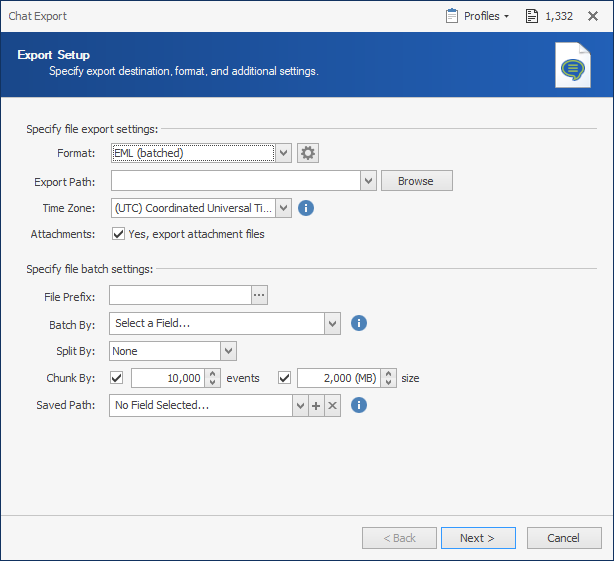
Specify file export settings section

Note: The selected Time Zone is used for any batching by date operations.
Specify file batch settings You can choose an (optional) batching strategy, which allows you to force conversations into their own EML file set. For example, you may want to batch on Custodian, Phone Owner, or Conversation/Thread ID. Since multiple conversations can exist in a single EML file, if you batch on Conversation or Thread ID, you can require exactly one conversation per EML file instead.
Note: Relativity recommends that an EML file should have no more than 10,000 events, so use batch settings that create files within these guidelines.
Note: The default values are set to match Relativity's requirements.
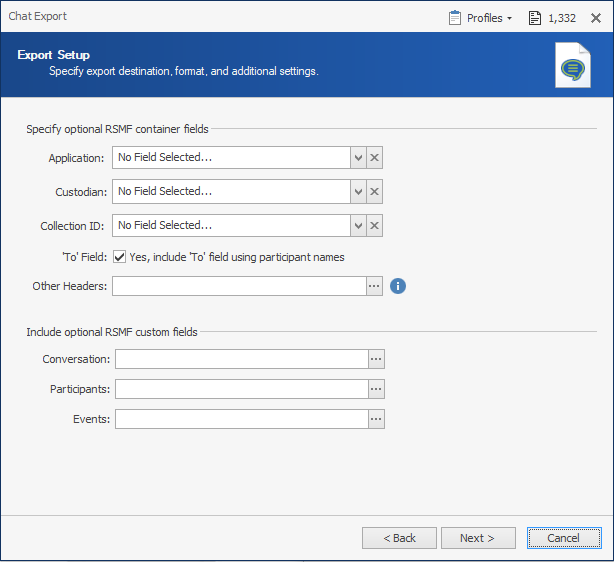
Specify optional EML container settings
'To' Field: Select to include 'To' field using participants names.
Other Headers: Click  and use the Select Fields dialog box to choose additional headers for the EML file. These are prefixed
and use the Select Fields dialog box to choose additional headers for the EML file. These are prefixed X-CHAT and can be mapped in processing.
Include optional EMF custom fields
Note: EML templates in ReadySuite configure the export, so the contents of the Conversation, Participants, and Events fields have no impact on the export.
Note: For more information on the required Chat fields and recommended content, please see Mapping Chat Fields.
If no default value appears in the Source Field, you can add a dynamic field.
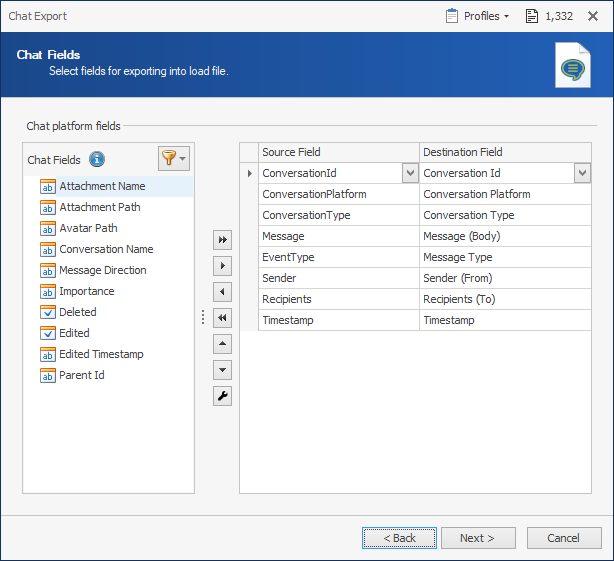
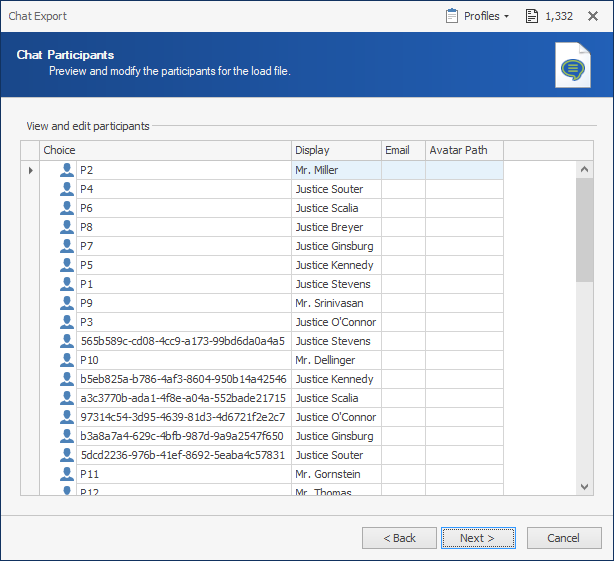
In the above example, the Choice value for Justice Ginsburg is set a new Display name for Notorious RBG (which would be saved into each EML file created with her name).
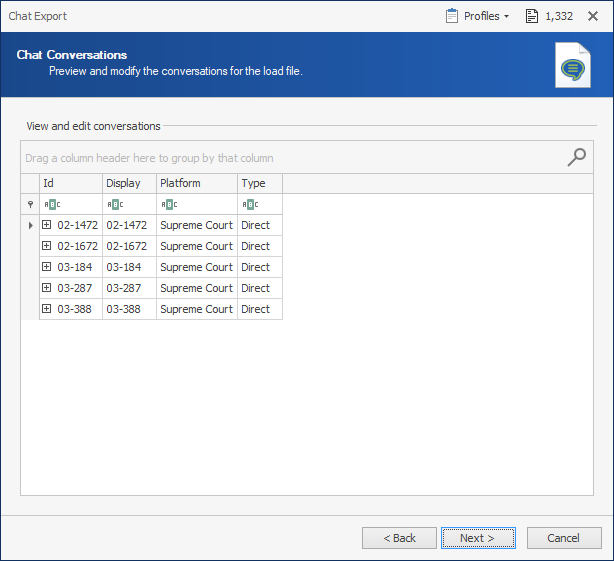
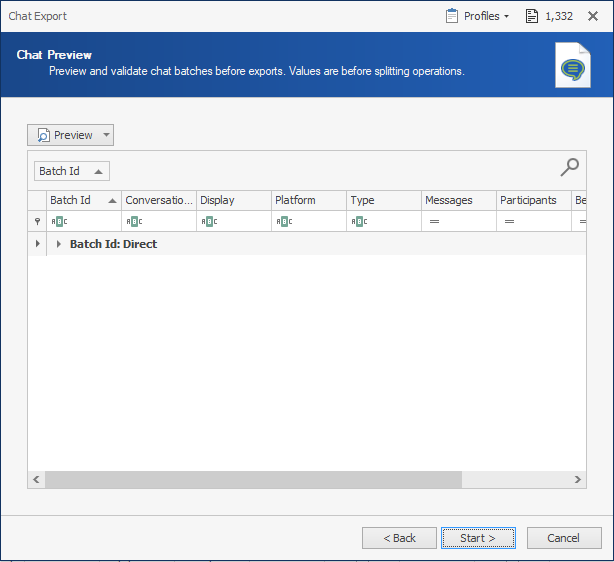
Note: If warnings exist, the Warnings icon ![]() displays the number of instances. Click to view the Event Log for details.
displays the number of instances. Click to view the Event Log for details.
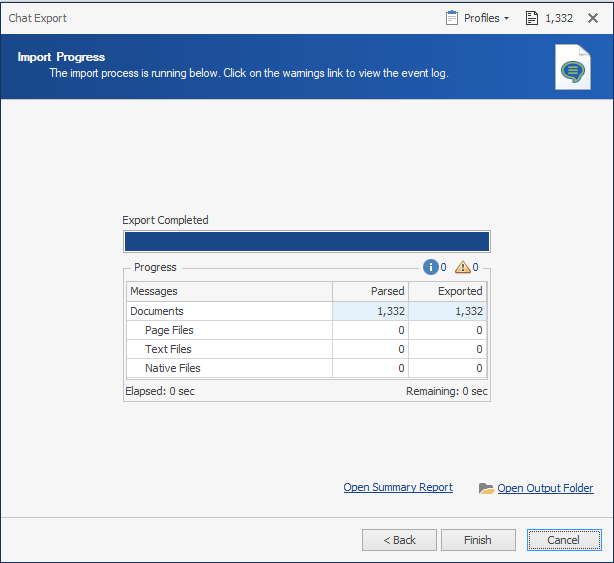
To view the Chat Export Report, click Open Summary Report.
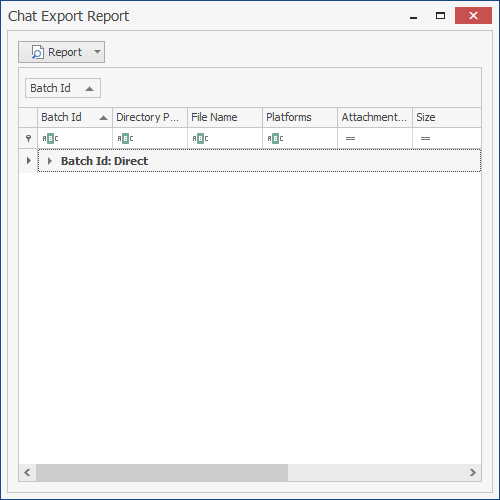
To view the output folder directory, click Open Output Folder.